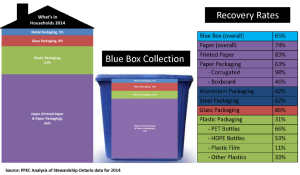It’s easy to describe plastics as the problem child of the Ontario Blue Box. Just look at the chart below. Its generation continues to increase; its volume fills trucks and landfills; its net cost to recycle is more than three times that of paper packaging; almost 70% of it heads to the dump.
While the plastics industry is making some efforts to render its packaging more easily recyclable, it’s also promoting energy-from-waste (EFW) as a solution for certain packaging grades. EFW may well be a solution to a waste management problem, but it is only one part of a larger issue, that of material choice and design, whether design for the environment or design for recycling.
The Ontario Ministry of Environment and Climate Change (MOECC) in its recently released Strategy document has called it correctly. It will not allow EFW to be defined as “waste diversion,” as the plastics industry would like. This is not mere quibbling over semantics. The MOECC is not opposed to EFW as a technology. But if EFW is defined as waste diversion then there is nothing to stop the plastics industry and plastic stewards from loudly proclaiming a 60, 70, 80 or 90% “diversion” rate for plastics which would put it on par with what most of the other packaging materials have already achieved through recycling (see graphic below). The plastics industry should not be given a free pass to keep pumping out more (mostly virgin) product without a reasonable effort to recycle more. Just over 30% doesn’t cut it.
One option might be to set two targets, one for recycling (i.e. diversion) and one for recovery (e.g. EFW), rather than to call them both diversion, because, as the MOECC argues, EFW is primarily a disposal option, about burning waste management residues.
There is another key element in this debate: the “message” that the Blue Box fees give to the users or stewards when they choose different packaging materials. The choice to use plastics should fairly reflect its total cost to manage throughout the Blue Box system. At the moment, the overall impact of the fee structure is to reward the materials with lower recycling rates, because the fees are so closely tied to net costs. Put another way, the more you recycle the higher the net costs. So the more plastics that are recycled, the higher the costs for the whole Blue Box.
This “message to stewards” issue will become even more important when Ontario stewards fund 100% of Blue Box costs, double what they pay now. It’s a bit of an understatement to say that the new fee structure currently being developed by the Canadian Stewardship Services Alliance (CSSA) will be one of the most closely scrutinised documents around. Everyone wants a more level playing field.

